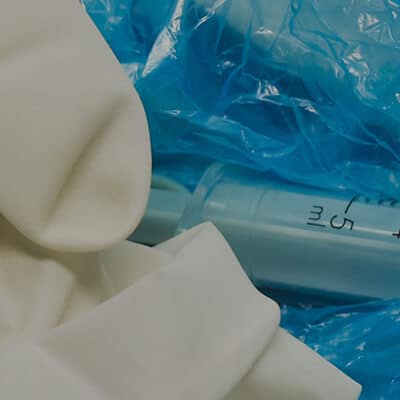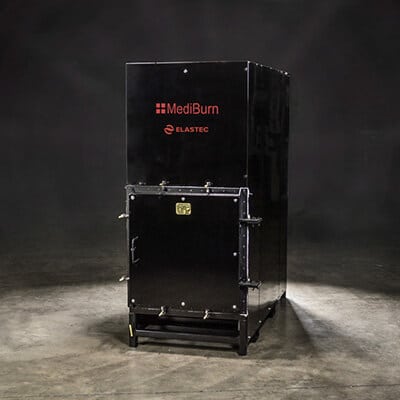Disposal of health-care waste

Incineration reduces organic and combustible waste to inorganic, incombustible matter and significantly reduces the volume and weight of the waste materials. Incineration temperatures range from about 200 ºC to more than 1000 ºC. Incinerators can range from extremely sophisticated, high-temperature plants to small, basic units.
Many types of health-care services create waste that may be hazardous to health. Eliminating this health-care waste safely can reduce the potential risks to people. Many countries are becoming more aware of the potential harm from health-care wastes. Managers and medical staff are expected to take more responsibility for the wastes they produce. Improper handling and disposal of infectious waste is now recognized as a source of avoidable infection and impact on the environment.
Hazardous health-care waste should be treated in a way to minimize its effect on health and the environment. Treatment can be done on-premises with a medical waste incinerator that meets the temperatures recommended by organizations like the WHO (World Health Organization) for eliminating infectious waste. When treating these materials onsite, the incinerator should be carefully selected based on characteristics, technology capacity and requirements, environment and safety factors, and cost.
TYPES OF HEALTH-CARE WASTE
The types of waste generated by hospitals, clinics, and laboratories can be sorted into different categories. These types of waste should be handled based on their specific characteristics. The following is a list of these types and a description of each.
Infectious waste
Infectious waste is waste that is suspected to contain pathogens such as bacteria, viruses, parasites or fungi in amounts large enough to cause disease in susceptible hosts. This category includes:
- Waste contaminated with blood or other body fluids
- Cultures and stocks of infectious agents from laboratory work
- Waste from infected patients in isolation wards
Waste contaminated with blood or other body fluids include free-flowing blood, blood components and other body fluids; dressings, bandages, swabs, gloves, masks, gowns, drapes and other material contaminated with blood or other body fluids; and waste that has been in contact with the blood of patients undergoing haemodialysis (e.g. dialysis equipment such as tubing and filters, disposable towels, gowns, aprons, gloves and laboratory coats).
Pathological waste
Pathological waste consists of tissues, organs, body parts, blood, body fluids and other waste from surgery and autopsies on patients with infectious diseases. It also includes human fetuses and infected animal carcasses. Recognizable human or animal body parts are sometimes called anatomical waste. Pathological waste may include healthy body parts that have been removed during a medical procedure or produced during medical research.
Pharmaceutical waste
Pharmaceutical waste includes expired, unused, spilt and contaminated pharmaceutical products, prescribed and proprietary drugs, vaccines and sera that are no longer required, and, due to their chemical or biological nature, need to be disposed of carefully. The category also includes discarded items such as bottles, vials and boxes containing pharmaceutical residues, gloves, masks and connecting tubing.
Non-hazardous general waste
Non-hazardous or general waste is waste that has not been in contact with infectious agents, hazardous chemicals or radioactive substances and does not pose a sharps hazard. According to the WHO about 85% of all waste from health-care facilities is non-hazardous waste. More than half of all non-hazardous waste from hospitals is paper, cardboard and plastics, while the rest comprises discarded food, metal, glass, textiles, plastics and wood.
SOURCES OF HEALTH-CARE WASTE
- Hospitals
- Emergency medical care services
- Health-care centers and dispensaries
- Obstetric and maternity clinics
- Outpatient clinics
- Dialysis centers
- Long-term health-care establishments and hospices
- Transfusion centers
- Military medical services
- Prison hospitals or clinics
- Medical and biomedical laboratories
- Biotechnology laboratories and institutions
- Medical research centers
- Mortuary and autopsy centers
- Animal research and testing
- Blood banks and blood collection services
- Nursing homes for the elderly
- Small health-care establishments
- First-aid posts and sick bays
- Physicians’ offices
- Dental clinics
- Acupuncturists
- Chiropractors
- Specialized health-care establishments and institutions with low waste generation
- Convalescent nursing homes
- Psychiatric hospitals
- Disabled persons’ institutions
- Activities involving intravenous or subcutaneous interventions
- Cosmetic ear-piercing and tattoo parlors
- Illicit drug users and needle exchanges
- Funeral services
- Ambulance services
- Home treatment
ELASTEC MEDIBURN MEDICAL WASTE INCINERATOR

The Elastec MediBurn is a portable medical waste incinerator that has been effectively used on-stie to dispose of hazardous waste during viral outbreaks like Ebola and COVID-19. MediBurn reaches temperatures of up to 1000ºC (1832ºF) and is able to destroy health care waste for laboratories, small clinics, and hospitals. It can meet the immediate need for waste elimination and public health protection where there is no access to more sophisticated technologies.
According to the World Health Organization (WHO): “The advantages of providing each health-care establishment with an on-site treatment facility includes convenience and minimization of risks to public health and the environment by confinement of hazardous / infectious health care waste to the health-care premises.”
The MediBurn can be used in conjunction with other disposal methods to set up on-site treatment facilities for clinics and hospitals that help minimize risk and handling of materials. It is available in two sizes and is able to incinerate up to 10 cubic feet (0.28 cubic meters) of waste with no smoke or smell during operation. Both models offer modulating burners and under-air technology. They also offer easy-to-use electronic controls for improved safety and system control and require minimal training. Multi-language support is available. The entire system only requires an electrical outlet, diesel fuel and minimal training.
PRECAUTIONS WHEN CONSIDERING INCINERATION
The disadvantage of incinerator technology is the production of gaseous emissions, including steam, carbon dioxide, and nitrogen oxides along with the residual ash. Because of this, they should be operated away from heavily populated areas and areas where food is being produced. According to the WHO, small-scale incinerators may be used when there is no access to more sophisticated technology and there is an immediate need for public health protection. Best practices should be employed if small-scale incinerators are the only option available to minimize the impact on the environment.
